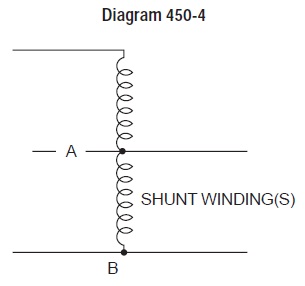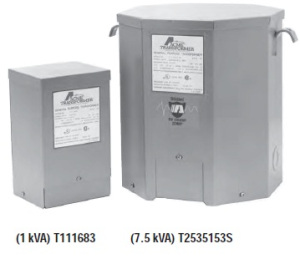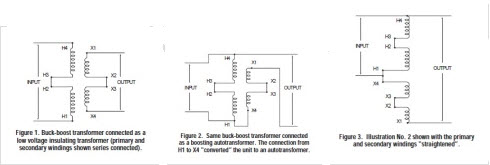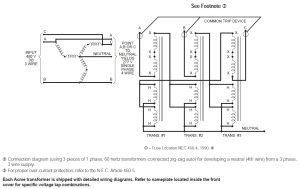Will the standard Zig-Zag connection shown in the Acme General Catalog serve as an I-Trap™?
No, the I-Trap™ is specifically designed to reduce high neutral currents.
To eliminate the problem of overheated neutral conductors, why not increase the size of the neutral?
First, increasing the neutral size does not eliminate the harmonic problem - they are still present in the system and may cause transformer overheating and possibly failure
Second, installation of a new neutral conductor in long runs may be difficult and cost prohibitive when compared to the cost of installing an I-Trap™ unit.
What advantage does the I-Trap™ have over harmonic filters?
Harmonic filters must be matched to their load and they may cause a leading power factor, which, when turned to a specific frequency, can actually aggravate the harmonic problem.
Will the I-Trap™ increase fault currents in my system?
The I-Trap™ will not increase three phase of phase-to-phase fault currents but can increase the available fault current on line to ground faults.
Will the I-Trap™ reduce phase amps?
Phase amps have been reduced by 18% in Acme laboratory tests. Depending on the conditions for a particular electrical system, the percentage will vary.
Will the I-Trap™ reduce neutral to ground voltages?
Yes, lab tests have shown significant reductions.
Is the I-Trap™ for use on 480/277V systems?
It is for use on 208Y/120V systems only. For other voltages, contact the factory.
Where should the I-Trap™ be installed in the system?
It is recommended that the I-Trap™ be installed as close as possible to the harmonic producing loads on the three phase system. This location would typically be on the line side of a distribution panel that feeds the harmonic producing equipment.
How do I select the correct I-Trap™ for my system?
A measurement of current flowing in neutral conductor from the load to the supply transformer will need to be taken with an RMS meter.
What causes a neutral current to flow in a balanced three phase system?
The vector addition of three phase fundamentals currents will add to zero on a balanced system without harmonics. However, if triplen* harmonic currents are present, they will add in the neutral.
With high concentrations of non-linear loads, the neutral current can be as high as two times the line current.
*Harmonics which are odd multiples of three (3rd, 9th, 15th, 21st, etc.). Odd triplen harmonics add together in the neutral conductor.
What is the I-Trap™?
The I-Trap™ is a version of a Zig-Zag autotransformer that has been designed to provide low zero sequence impedance.
I have noted the reprint of the N.E.C. (National Electrical Code), Article 450-4 in the question covering autotransformer overcurrent protection. Could you explain this article in detail citing an example?
An example of an everyday application is always a good way to explain the intent of the "Code."
Example: A 1 kVA transformer Catalog No. T111683 has a primary of 120 x 240V and a secondary 12 x 24V. It is to be connected as an autotransformer at the time of installation to raise 208V to 230V single phase.
When this 1 kVA unit is connected as an autotransformer for this voltage combination, its kVA rating is increased to 9.58 kVA (may also be expressed at 9,580 VA). This is the rating to be used for determining the full load input amps and the sizing of the overcurrent protect device (fuse or breaker) on the input.

When the full load current is greater than 9 amps, the overcurrent protective device (usually a fuse or nonadjustable breaker) amp rating can be up to 125 percent of the full load rating of the autotransformer input amps.

The National Electrical Code, Article 450-4 (a) Exception, permits the use of the next higher standard ampere rating of the overcurrent device. This is shown in Article 240-6 of the N.E.C.

A buck-boost transformer is suitable for connecting as an autotransformer. What is the definition of an autotransformer and how does it differ from an isolation transformer?
An autotransformer is a transformer in which the primary (input) and the secondary (output) are electrically connected to each other.
An isolation transformer., also known as an insulating transformer, has complete electrical separation between the primary (input) and the secondary (output).
This is illustrated in the drawing below:

An autotransformer changes or transforms only a portion of the electrical energy it transmits. The rest of the electrical energy flows directly through the electrical connections between the primary and secondary. An isolation transformer (insulating transformer) changes or transforms all of the electrical energy it transmits. Consequently, an autotransformer is smaller, lighter in weight, and less costly than a comparable kVA size insulating transformer.
When a buck-boost transformer is connected as an autotransformer such as boosting 208V to 230V, the kVA is greatly increased. What is the procedure for determining the size (ampere rating) of the overcurrent protective device such as a fuse or circuit breaker?
The National Electrical Code Article 450-4 addresses overcurrent protection of autotransformers. A copy is reproduced below for easy reference. 450-4. Autotransformers 600 Volts, Nominal, or Less.
(a) Overcurrent Protection. Each autotransformer 600 volts, nominal, or less shall be protected by an individual overcurrent device installed in series with each ungrounded input conductor. Such overcurrent device shall be rated or set at not more than 125 percent of the rated full-load input current of the autotransformer. An overcurrent device shall not be installed in series with the shunt winding (the winding common to both the input and the output circuits) of the autotransformer between Points A and B as shown in diagram 450-4.

Exception: Where the rated input current of an autotransformer is 9 am peres or more and 125 percent of this current does not correspond to a standard rating of a fuse or non-adjustable circuit breaker, the next higher standard rating described in Section 240-6 shall be permitted. When the rated input current is less than 9 amperes, an overcurrent device rated or set at not more than 167 percent of the input current shall be permitted.
(b) Transformer Field-Connected as an Autotransformer. A transformer field-connected as an autotransformer shall be identified for use at elevated voltage.
Buck-boost transformers are almost always installed as autotransformers. Does the N.E.C. (National Electrical Code) permit the use of autotransformers?
Yes, please refer to N.E.C. Article 450-4, “Autotransformers 600 Volts, Nominal, or Less.” Item (a) explains how to overcurrent protect an autotransformer; item (b) explains that an insulating transformer such as a buck-boost transformer may be field connected as an autotransformer.
What is the life expectancy of a buck boost transformer?
The life expectancy of a buck-boost transformer is the same as the life expectancy of other dry type transformers.
Are buck-boost transformers as quiet as standard isolation transformers?
Yes, however, an auto-connected buck-boost transformer will be quieter than an isolation transformer capable of handling the same load. The isolation transformer would have to be physically larger than the buck-boost transformer, and small transformers are quieter than larger ones.
(Example) 1 kVA — 40 db; 75 kVA — 50 db. (db is a unit of sound measure).
Do buck-boost transformers present a safety hazard usually associated with autotransformers?
No, most autotransformers, if they are not of the buck-boost variety, change voltage from one voltage class to another.
(Example 480V to 240V) In a system where one line is grounded, the user thinks he has 240V; yet due to the primary and secondary being tied together, it is possible to have 480V to ground from the 240V output. A buck-boost transformer only changes the voltage a small amount, such as 208V to 240V. This small increase does not represent a safety hazard, as compared to a buck of 480V to 240V.

Why is the isolation transformer kVA rating shown on the nameplate instead of the autotransformer kVA rating?
The kVA rating of a buck-boost transformer when auto connected depends on the amount of voltage buck or boost. Since the amount of voltage buck or boost is different for each connection, it is physically impossible to show all of the various voltage combinations and attainable kVA ratings on the nameplate.
A connection chart showing the various attainable single phase and three-phase connections is packed with each unit.
Why are buck-boost transformers shipped from the factory as insulating transformers and not preconnected at the factory as autotransformers?
A four winding buck-boost transformer can be auto connected eight different ways to provide a multitude of voltage and kVA output combinations.
The proper transformer connection depends on the user’s supply voltage, load voltage and load kVA. Consequently, it is more feasible for the manufacturer to ship the unit as an insulating transformer and allow the user to connect it on the job site in accordance with the available supply voltage and requirements of his load.
Can 60 Hertz buck-boost transformers be used on a 50 Hertz service?
No. Acme buck-boost transformers should be operated only at the frequencies recommended. However, units recommended for 50 cycle operation are suitable for 60 cycle operation but not vice versa.
How does the installer or user know how to connect a buck-boost transformer?
The connection chart packed with each unit shows how to make the appropriate connections. These same connection charts are also shown below.

Why isn't a closed delta buck-boost connection recommended?
A closed delta buck-boost auto transformer connection requires more transformer kVA than a “wye” or open delta connection and phase shifting occurs on the output. Consequently the closed delta connection is more expensive and electrically inferior to other three-phase connections.
Should buck-boost transformers be used to develop a three-phase 4 wire Y circuit from a three-phase 3 wire delta circuit?
No,a three phase “wye” buck-boost transformer connection should be used only on a 4 wire source of supply. A delta to wye connection does not provide adequate current capacity to accommodate unbalanced currents flowing in the neutral wire of the 4 wire circuit.

Can buck-boost transformers be used on three-phase systems as well as single phase systems?
Yes, a single unit is used to buck or boost single phase voltage — two or three units are used to buck or boost three phase voltage.
The number of units to be used in a three – phase installation depends on the number of wires in the supply line. If the three-phase supply is 4 wire Y, use three buck-boost transformers. If the 3-phase supply is 3 wire Y (neutral not available), use two buck-boost transformers.
Can buck-boost transformers be used on motor loads?
Yes, either single or three phase. Refer to the motor data chart below for determining kVA and Amps required by NEMA standard motors.

Why can a buck-boost transformer operate a kVA load many times larger than the kVA rating on its nameplate?
Since the transformer has been auto-connected in such a fashion that the 22V secondary voltage is added to the 208V primary voltage, it produces 230V output.
The autotransformer kVA is calculated:

For our example:

The picture to the below illustrates the difference in physical size between the autotransformer of 1 kVA, capable of handling a 9.58 kVA load, and an isolation transformer capable of handling a 7.5 kVA load.

To cite an example… a model T111683 buck-boost transformer has a nameplate kVA rating of 1 kVA, but when it’s connected as an autotransformer boosting 208V to 230V, its kVA capacity increases to 9.58 kVA.
The key to understanding the operation of buck-boost transformers lies in the fact that the secondary windings are the only parts of the transformer that do the work of transforming voltage and current.
In the example above, only 22 volts are being transformed (boosted) — i.e. 208V + 22V = 230V. This 22V transformation is carried out by the secondary windings which are designed to operate at a maximum current of 41.67 amps (determined by wire size of windings).

For our example:

Are there any restrictions on the type of load that can be operated from a buck-boost transformer?
No, there are no restrictions
Will a buck-boost transformer stabilize voltage?
No. The output voltage is a function of the input voltage. If the input voltage varies, then the output voltage will also vary by the same percentage.
Why do buck-boost transformers have 4 windings?
To make them versatile! A four winding buck-boost transformer (2 primary and 2 secondary windings) can be connected eight different ways to provide a multitude of voltage and kVA outputs. A two winding (1 primary & 1 secondary) buck-boost transformer can be connected only one way.
Can buck-boost transformers be used to power low voltage circuits?
Yes, low voltage control, lighting circuits, or other low voltage applications requiring either 12V, 16V, 24V, 32V or 48V. The unit is connected as an insulating transformer and the nameplate kVA rating is the transformer’s capacity.
What are the most common applications for buck-boost transformers?
Boosting 208V to 230V or 240V and vice versa for commercial and industrial air conditioning systems; boosting 110V to 120V and 240V to 277V for lighting systems; voltage correction for heating systems and induction motors of all types. Many applications exist where supply voltages are constantly above or below normal.
Why are Buck-Boost transformers used?
Electrical and electronic equipment is designed to operate on standard supply voltage. When the supply voltage is constantly too high or too low, (usually more than 55%), the equipment fails to operate at maximum efficiency. A buck and boost transformer is a simple and ECONOMICAL means of correcting this off-standard voltage.
What is the difference between a buck-boost transformer and an autotransformer?
When a primary lead wire and secondary lead wire of a buck-boost transformer are connected together electrically, in a recommended voltage bucking or boosting connection, the transformer is in all respects, an auto transformer. However, if the inter connection between the primary and secondary winding is not made, then the unit is an insulating type transformer.
How does a buck-boost transformer differ from an insulating transformer?
A buck-boost transformer IS an insulating type transformer when it is shipped from the factory. When it is connected at the job site, a lead wire on the primary is connected to a lead wire on the secondary – thereby changing the transformer’s electrical characteristics to those of an autotransformer.
The primary and secondary windings are no longer “insulated” and secondary windings are no longer “insulated” and its kVA capacity is greatly increased. Refer to figures 1, 2 and 3.

What is a buck-boost transformer?
Buck-boost transformers are small single phase transformers designed to reduce (buck) or raise (boost) line voltage from 5-20%.
The most common example is boosting 208 volts to 230 volts, usually to operate a 230 volt motor such as an air conditioner compressor, from a 208 volt supply line.
Buck-boosts are a standard type of single phase distribution transformers, with primary voltages of 120, 240 or 480 volts and secondaries typically of 12, 16, 24, 32 or 48 volts. They are available in sizes ranging from 50 volt amperes to 10 kilo-volt amperes. Buck-boost transformers are shipped ready to be connected for a number of possible voltage combinations.
What are typical applications for transfomers?
Acme transformers should be specified to:
1. Distribute power at high voltage.
2. Eliminate double wiring.
3. Operate 120 volt equipment from power circuits.
4. Insulate circuits/establish separately derived circuits.
5. Provide 3-wire secondary circuits.
6. Buck and Boost.
7. Provide electrostatic shielding for transient noise protection.
How is an Acme Drive Isolation Transformer (DIT) different than a General Purpose Transformer?
DITs, as the name implies, are designed to be used with motor drives (AC and DC) and to provide isolation from the service line. They are specifically designed to withstand the “short circuit like” duty imposed by the firing of the thyristors.
Harmonics generated by drives create added loads on the transformer. Therefore, it is important that a transformer of equal or greater KVA to that recommended by the drive manufacturer be installed for a particular motor application.
Will a transformer change Three Phase to Single Phase?
A transformer will not act as a phase changing device when attempting to change three phase to single phase. There is no way that a transformer will take three phase in and deliver single phase out while at the same time presenting a balanced load to the three phase supply system.
There are, however, circuits available to change three phase to two phase or vice versa using standard dual wound transformers.
Please contact the factory for two phase applications.
What is BIL and how does it apply to Acme transformers?
BIL is an abbreviation for Basic Impulse Level. Impulse tests are dielectric tests that consist of the application of a high frequency steep wave front voltage between windings, and between windings and ground.
The Basic Impulse Level of a transformer is a method of expressing the voltage surge (lightning, switching surges, etc.) that a transformer will tolerate without breakdown.
All transformers manufactured by Acme, 600 volts and below, will withstand the NEMA standard BIL rating, which is 10 KV. This assures the user that he will not experience breakdowns when his system is properly protected with lightning arrestors or similar surge protection devices.
Is CSA certification available for Acme Transformers?
Most ACME transformers are certified by Canadian Standards Association. They have been designed and tested in accordance with the latest specifications.
Please contact the factory if further details are required.
Are Acme Transformers U.L. Listed?
All of the transformers, with few exceptions, are listed by Underwriters’ Laboratories and have met their rigorous requirements. We are also prepared to have transformers, which are not presently listed, submitted for listing to Underwriters’ upon the customer’s request.
Please contact the factory for details.
What color are Acme Dry-Type Transformers?
ASA 61 (NEMA) light gray is used on all enclosed transformers from .050 to 1000 KVA.
Does Acme provide “Zig-Zag” Grounding Transformers?
Yes, please refer below for a special diagram which can be used to connect standard single phase off-the-shelf transformers in a three phase zig-zag manner. This system can be used for either grounding or developing a fourth wire from a three phase neutral.
An example would be to change a 480 V — three phase — three wire system to a 480Y/277 V — three phase — four wire system.
